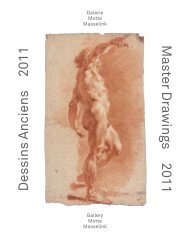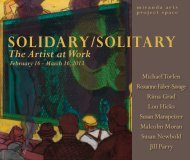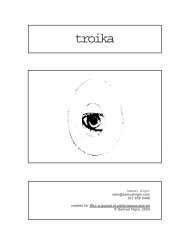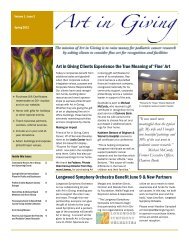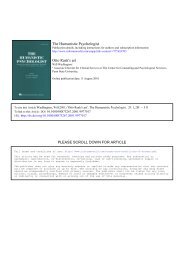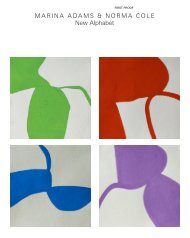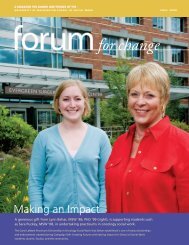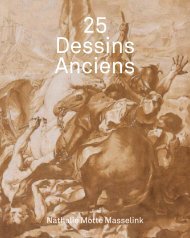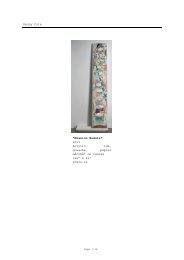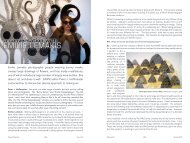Micah Williams Portrait Artist - Icompendium
Micah Williams Portrait Artist - Icompendium
Micah Williams Portrait Artist - Icompendium
You also want an ePaper? Increase the reach of your titles
YUMPU automatically turns print PDFs into web optimized ePapers that Google loves.
figure no. 6<br />
<strong>Micah</strong> <strong>Williams</strong>’ signature at the end<br />
of his four-page list of creditors.<br />
Courtesy of the New Jersey State<br />
Archives, Trenton, NJ.<br />
willing to lend the money he requested or extend credit for goods and<br />
services. More than a few persons lent <strong>Williams</strong> considerable sums and then<br />
apparently waited for some time before pressing him for payments.<br />
<strong>Micah</strong> <strong>Williams</strong>’ creditor list reveals his social and political affiliations<br />
as well. Several names on the list were both Federalists and members of<br />
the Washington Benevolent Society. Considered America’s first political<br />
party, the Federalist Party was begun by Alexander Hamilton as a way to<br />
gather support for his economic policies. Many members were bankers<br />
and businessmen who supported the formation of a national bank, the<br />
placement of trade tariffs, and cordial diplomatic relations with Great<br />
Britain. Gradually, however, the swell of popular support for the War of<br />
1812 and its fight against Great Britain so severely damaged the Federalist<br />
Party that it never recovered its earlier political strength, eventually failing<br />
altogether in 1829. (26)<br />
The Washington Benevolent Society was founded by New York Federalists<br />
in 1808. Members wore printed silk lapel ribbons and badges, many sporting<br />
George Washington’s image. Society members strongly opposed President<br />
James Madison’s foreign policies and for a time openly supported secession<br />
from the United States. (27) <strong>Micah</strong> <strong>Williams</strong> owed various sums to Abraham<br />
Blauvelt ($10), John Neilson ($5), and Nicholas Van Brunt (“unsettled”) all of<br />
whom were members of the Washington Benevolent Society and prominent<br />
New Brunswick residents. Nicholas Van Brunt was the owner of the Swan<br />
Tavern on Albany Street in New Brunswick. Van Brunt was one of the leading<br />
organizers of the Washington Benevolent Society and hosted its first meeting<br />
on 2 December 1811 at his tavern. He was instrumental in the construction<br />
of a meeting hall for the Society, which was formally dedicated on 4 July<br />
1813, with a parade, banquet, and speeches. John Neilson was a successful<br />
businessman, Federalist and Benevolent Society member. Abraham Blauvelt<br />
was editor and publisher of the Guardian or New-Brunswick Advertiser and was<br />
highly active in local politics. (28) Although it is unknown whether <strong>Micah</strong><br />
<strong>Williams</strong> was a member of the Society, his association with known members<br />
makes it a possibility that <strong>Williams</strong> was also a member of this activist group.<br />
Thirty-two year old <strong>Williams</strong> spent approximately two months in debtors’<br />
prison. His property had been seized and auctioned, his and his family’s<br />
personal belongings were gone, and he had to find some way to rebuild<br />
his life and support a wife and four children, one of them a newborn baby.<br />
Under New Jersey debtor law, when <strong>Williams</strong> was released from prison in<br />
January of 1815, he was allowed to keep the clothes on his back and the backs<br />
of his family and ten dollars’ worth of the tools of his trade. There are no<br />
indications <strong>Williams</strong> ever practiced silver plating again.<br />
Debtors were required to sign or, in cases of illiterate debtors, inscribe their “X” mark<br />
to, their creditor lists. At the bottom of the list of 123 men to whom he owed well in<br />
excess of $5,000, literally marking the end of his initially successful career as a silver<br />
plater, <strong>Micah</strong> <strong>Williams</strong> signed his name large and boldly, with a flourish beneath, almost<br />
as if he were anticipating his new career as a traveling portrait artist.<br />
A Second Career<br />
After his release from prison, <strong>Micah</strong> <strong>Williams</strong> quickly embarked on a new artistic<br />
career. By the spring of 1815, he had begun to create pastel portraits of local residents.<br />
In the 15 July 1815 issue of the New Brunswick newspaper Fredonian, <strong>Williams</strong>’ name<br />
appears as having letters “remaining on hand at the Post Office, New Brunswick,”<br />
suggesting that within six months of his release, the former silver plater may already<br />
have been traveling for his new career. (29)<br />
<strong>Williams</strong> joined the ranks of practicing artists at a time when America was defining<br />
itself as a nation culturally and socially. Noah Webster, considered the father of<br />
American education, urged his fellow citizens, “Americans . . . you have an empire to<br />
raise and support by your exertions and a national character to establish and extend by<br />
your wisdom and virtues.” (30) <strong>Micah</strong> <strong>Williams</strong> joined an active group of craftsmen<br />
and women on the roads of early nineteenth century America. A surprising number of<br />
men and women chose to make their livelihood by traveling in search of customers.<br />
During his travels, <strong>Williams</strong> would have encountered dancing and singing masters,<br />
preachers, lecturers, and peddlers selling everything from shoes to books, as well as<br />
menageries and circus troupes, all seeking continued patronage.<br />
Family portraits, once available to only a small fraction of Americans, were in the first<br />
decades of the nineteenth century a desirable and affordable possession by those who<br />
had achieved economic success and could now afford such consumer goods. Patrons of<br />
traveling artists began to consider portraits as a visible and powerful representation of<br />
their achievement. (31) The desire of rural residents to add handsome family portraits<br />
to their homes resulted in early American art critic John Neal’s comment, “ . . . you can<br />
hardly open the door of a best room anywhere, without surprising or being surprised by<br />
the picture of somebody plastered to the wall, and staring at you with both eyes and a<br />
bunch of flowers.” (32)<br />
It is challenging to identify the earliest <strong>Micah</strong> <strong>Williams</strong> portrait. The artist’s style<br />
remained virtually unchanged over the years, so portraits with a decade between them<br />
appear as if they had been done at the same time. In addition, very few are inscribed<br />
with specific completion dates. Out of 272 identified <strong>Micah</strong> <strong>Williams</strong> portraits, only<br />
eleven are inscribed with a month, day, and year of completion, while an additional six<br />
are inscribed with the completion year.<br />
12 <strong>Micah</strong> <strong>Williams</strong>: <strong>Portrait</strong> <strong>Artist</strong> <strong>Micah</strong> <strong>Williams</strong>: <strong>Portrait</strong> <strong>Artist</strong> 13



